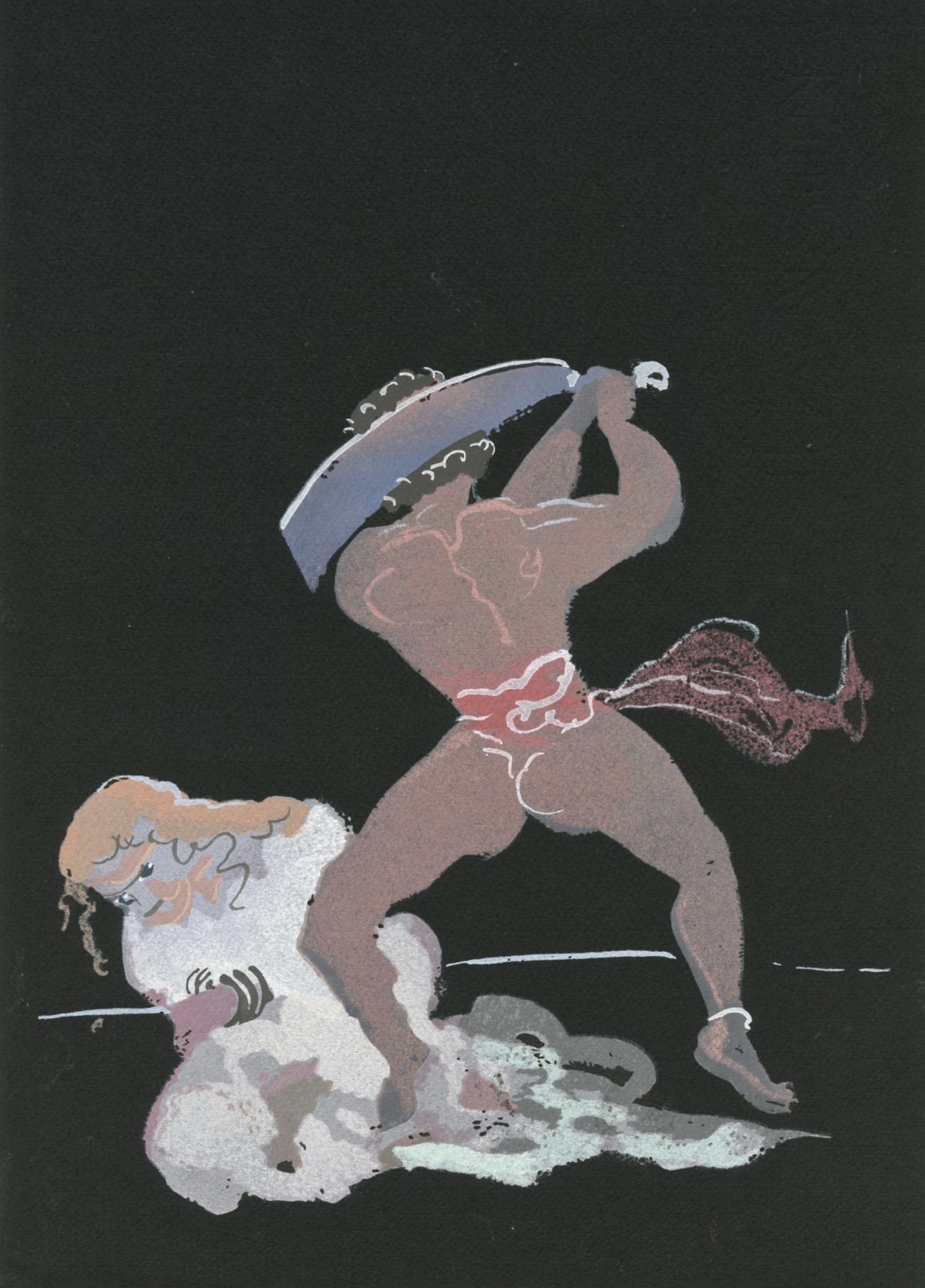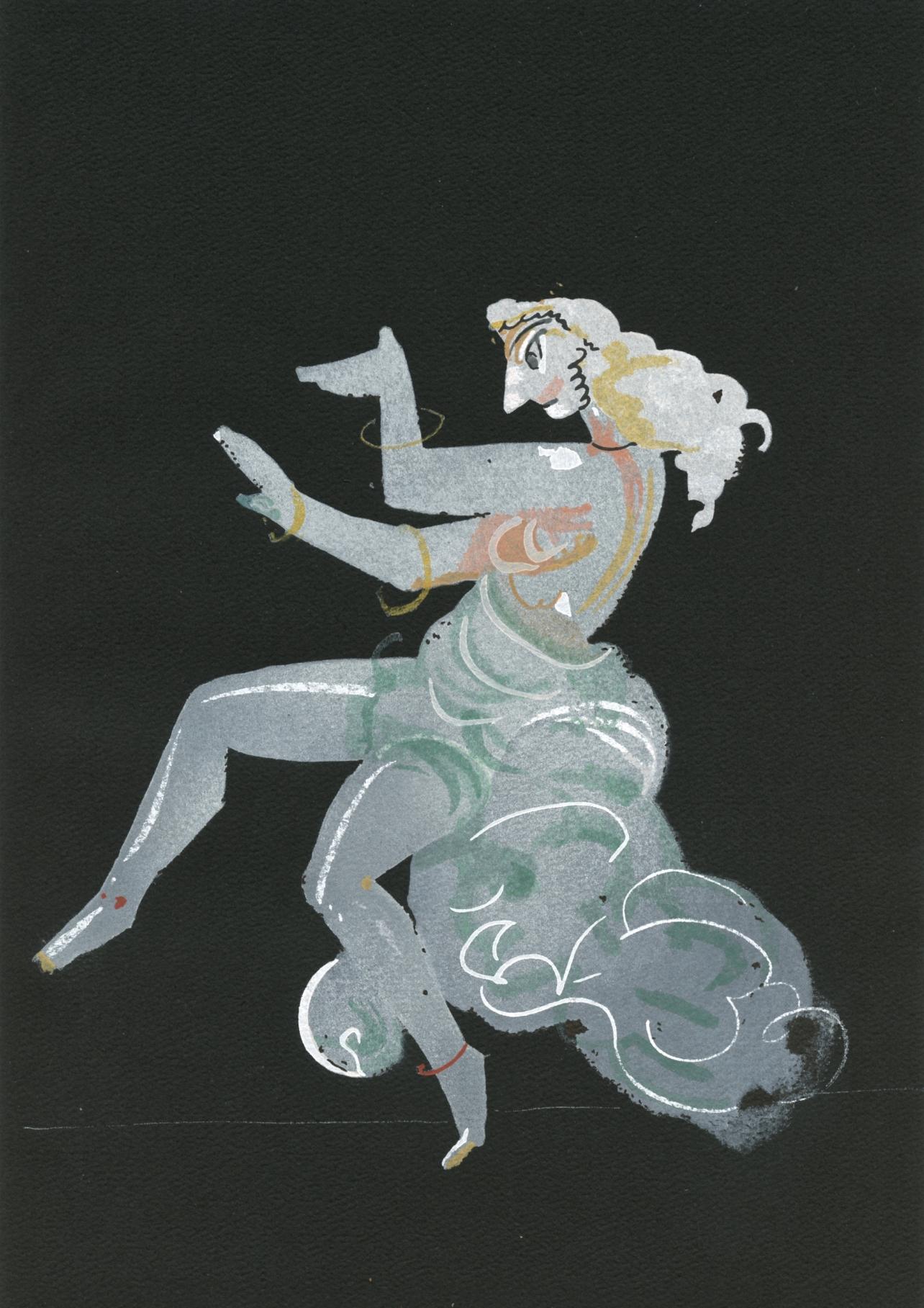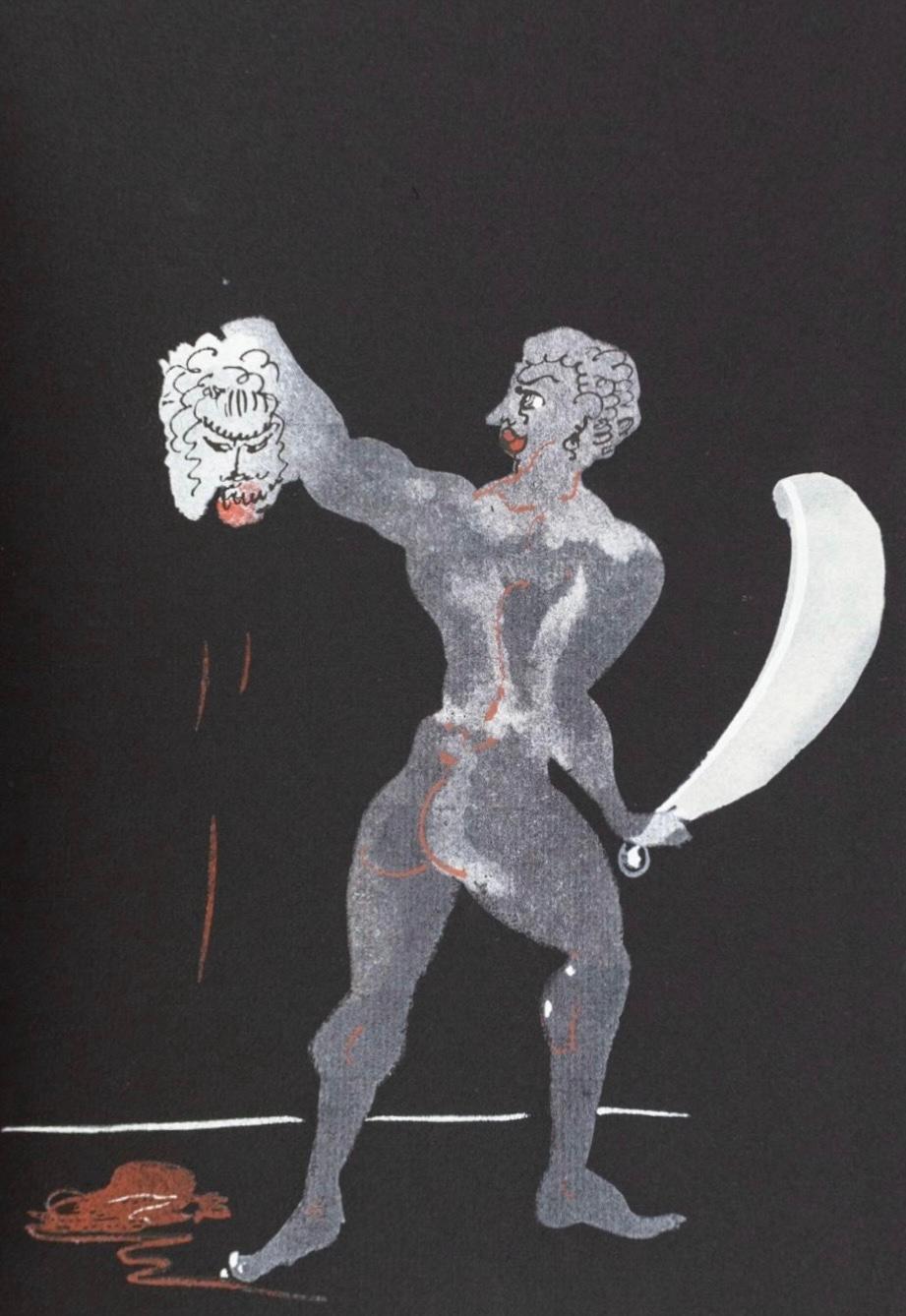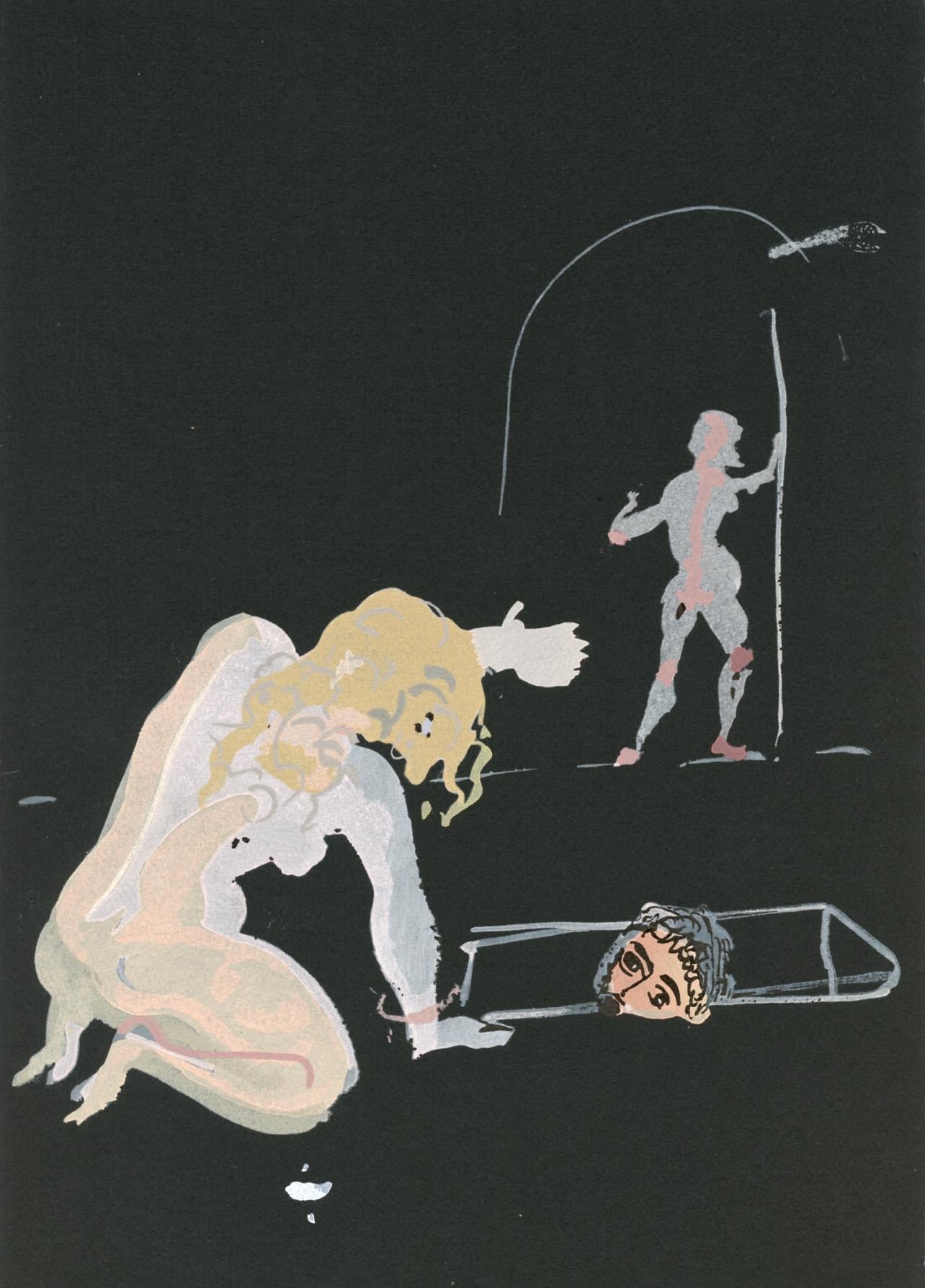Items Similar to Derain, Composition, Salomé, The Limited Editions Club (after)
Want more images or videos?
Request additional images or videos from the seller
Derain, Composition, Salomé, The Limited Editions Club (after)1938
1938
About the Item
Lithograph, Stencil on wove paper. Inscription: Unsigned and unnumbered. Good condition. Notes: From the volume, Salomé published by The Limited Editions Club, Paris; rendered by Jean Saudé, Paris; printed by Dehon et Cie, Faubourg-Saint-Denis, Paris, 1938. Excerpted from the volume, This edition of Salomé, printed in the original French as Oscar Wilde wrote it, consists of fifteen hundred copies for the members of the Limited Editions Club. It is designed by René Ben Sussan and printed by Dehon et Cie. In the Faubourg-Saint-Denis, Paris, the type being a new face designed by A.M. Cassandre, called Peignot and set by hand. The illustrations are gouache drawings on black paper by André Derain
reproduced through the pochoir process by Saudé in Paris. Excerpted from The Monthly Letter of The Limited Editions Club, July 1938, Number 110, On the left bank of the river which winds through Paris, behind the Boulevard Saint-Germain upon the sidewalks of which the French artists and American tourists sip their apéritifs and watch other French artists and other American tourists passing by, there is an historic little street. It is not a street in the broad sense at all, it is a narrow alley not twenty paces long, comprising two pairs of houses, their facades stained by the centuries, facing each other over cobbled stones worn smooth by the centuries. It is called the Cour de Rohan. You go into the second house on the right through a door which opens directly upon an chormous room; a room with a worn board floor, high ceilings, windows which look out on the cobbled stones, and no furniture whatever, not a chair not a table not a lamp, only a great artist's castle and a flat low model's throne. In this room Messieurs Danton and Marat met to plan the overthrow of the French aristocracy. In this room Monsieur Guillotin spread a paper over a desk and sketched the efficient machine which later cut off the heads of the French aristocracy. And in this room we cm-barked upon the exciting adventure of creating for you our members a new edition of Salomé. We dian't know at the moment that it would prove an exciting adventure; we didn't know, when we first told you about it in the prospectus for our Ninth Scries, how exciting the adventure would prove. This month your copy of Salomé is going to you and we now tell you about the adventure. It was André Derain who started it. He is an enormous hulk of a man. He is one of the most famous painters in the world. But he was not intended to be. He was born in 188o, in a little place called Chatou near Paris. His father was a superlative pastry cook, who therefore intended André to be an engincer. But, when André was only nine-teen, he met Maurice de Vlaminck, a man thirty years his senior who proceeded to interest him in painting and in painting like Cézanne. He went to Paris to study, and for years turned out paintings under the influence of Gauguin and Van Gogh and Cézanne. The art critics now call this his Gothic period, for he used the color schemes of the Gothic era and the Italian primitives such as Giotto and Cimabue. But then he came into contact with the works of Matisse and Picasso and their friends. These painters were called les fauves, because even their followers thought of them as wild animals. After the war, however, he broke away from their influence and came under the spell of the art of Renoir. Derain is now considered a painter whose design is rhythmical and finely balanced, with a range of color deliberately restricted. There have been exhibitions of the paintings of André Derain in New York and Cincinnati and Chicago as well as in all the principal cities of Europe. There have been nine books written about his life and works, one by Elie Faure in 1923. At this moment, his paintings are in even greater demand than the paintings of Picasso and Matisse. These paintings are hung in nearly all the principal mu-scums of the world. And Monsieur Derain has also illustrated books. That is why we went to see him, in his bare and historic studio in the Cour de Rohan. We wanted him to illustrate Prosper Merimée's Carmen, because we wanted him to make pictures of the female figure. He didn't like that idea, he said he was not interested in the period and the costumes required for a series of proper illustrations to Carmen. Then we suggested twelve other books. Then he suggested fourteen other books. Suddenly there was a dramatic pause, he lifted his enormous bulk off the window sill, he pointed a portentous finger at us, and he said: Salomé. So we said All right, little knowing the excitement of the adventure we were embarking upon. After we had gone through the delightful formality of signing a contract with André Derain, whereby he undertook to make a series of illustrations for Salomé by Oscar Wilde, we thought it would be a fine thing to have the edition printed in Paris, but printed in the English language. We did not know what would happen when we went across the Channel to London, to met with Holbrook Jackson. Mr. Holbrook Jackson is a kindly English gentleman, who edits a chain of trade papers for the world of the nineteen thirties but himself lives in the eighteen nineties. He is an authority upon the 'nineties, he knows with exactly what impatience John Lane greeted Aubrey Beardsley when Beardsley came to see him in his new shop in Vigo Street; he knows exactly how Oscar Wilde turned his back when he passed the Marquis of Queensberry in the street. His own book about the eighteen nineties is fascinating reading. We went to him, to ask him to write an introduction for our edition of Salomé. Before we left him, we knew more about the writing of Salomé than we ever thought we would know. We will tell you what we learned: When Oscar Wilde wrote Salomé, he was at the height of his powers. The year was 18g1, a year in which he published four books, The Picture of Dorian Gray, Intentions, Lord Arthur Savile's Crime and A House of Pomegran.
ANDRE DERAIN (1880-1954) had a major role in the development of two of the most significant artistic movements of the early-20th century. He, Henri Matisse, and Maurice de Vlaminck were responsible for generating works with a totally new style which would become Fauvism and his association with Pablo Picasso and Georges Braque was integral to early Cubism. Nevertheless, his contribution as the generator of the ideas behind these movements is constantly debated, and some consider his work derivative. This is due in part to the fact that, continually in search of artistic meaning and attempting to create a timeless art removed from the specificity of the modern age, he experimented with different stylistic idioms. Whichever side of the Derain debate you end up on, we can all appreciate his use of expressive vibrant color, his simplification of form, and his fascination with primitive art were constants throughout his work and played a major role in the creation and propagation of early Modern Art.
- Creation Year:1938
- Dimensions:Height: 11 in (27.94 cm)Width: 7.5 in (19.05 cm)
- Medium:
- Movement & Style:
- After:André Derain (1880-1954, French)
- Period:
- Condition:
- Gallery Location:Auburn Hills, MI
- Reference Number:1stDibs: LU1465214327472
About the Seller
4.9
Gold Seller
These expertly vetted sellers are highly rated and consistently exceed customer expectations.
Established in 2002
1stDibs seller since 2021
865 sales on 1stDibs
Typical response time: <1 hour
- ShippingRetrieving quote...Ships From: Clinton Township, MI
- Return PolicyA return for this item may be initiated within 1 day of delivery.
Auctions on 1stDibs
Our timed auctions are an opportunity to bid on extraordinary design. We do not charge a Buyer's Premium and shipping is facilitated by 1stDibs and/or the seller. Plus, all auction purchases are covered by our comprehensive Buyer Protection. Learn More
More From This SellerView All
- Derain, Composition, Salomé, The Limited Editions Club (after)By André DerainLocated in Auburn Hills, MILithograph, Stencil on wove paper. Inscription: Unsigned and unnumbered. Good condition. Notes: From the volume, Salomé published by The Limited Editions Club, Paris; rendered by Jea...Category
1930s Modern Abstract Prints
MaterialsLithograph, Stencil
- Derain, Composition, Salomé, The Limited Editions Club (after)By André DerainLocated in Auburn Hills, MILithograph, Stencil on wove paper. Inscription: Unsigned and unnumbered. Good condition. Notes: From the volume, Salomé published by The Limited Editions Club, Paris; rendered by Jea...Category
1930s Modern Abstract Prints
MaterialsLithograph, Stencil
- Derain, Composition, Salomé, The Limited Editions Club (after)By André DerainLocated in Auburn Hills, MILithograph, Stencil on wove paper. Inscription: Unsigned and unnumbered. Good condition. Notes: From the volume, Salomé published by The Limited Editions Club, Paris; rendered by Jea...Category
1930s Modern Abstract Prints
MaterialsLithograph, Stencil
- Derain, Composition, Salomé, The Limited Editions Club (after)By André DerainLocated in Auburn Hills, MILithograph, Stencil on wove paper. Inscription: Unsigned and unnumbered. Good condition. Notes: From the volume, Salomé published by The Limited Editions Club, Paris; rendered by Jea...Category
1930s Modern Abstract Prints
MaterialsLithograph, Stencil
- Derain, Composition, Salomé, The Limited Editions Club (after)By André DerainLocated in Auburn Hills, MILithograph, Stencil on wove paper. Inscription: Unsigned and unnumbered. Good condition. Notes: From the volume, Salomé published by The Limited Editions Club, Paris; rendered by Jea...Category
1930s Modern Abstract Prints
MaterialsLithograph, Stencil
- Derain, Composition, Salomé, The Limited Editions Club (after)By André DerainLocated in Auburn Hills, MILithograph, Stencil on wove paper. Inscription: Unsigned and unnumbered. Good condition. Notes: From the volume, Salomé published by The Limited Editions Club, Paris; rendered by Jea...Category
1930s Modern Abstract Prints
MaterialsLithograph, Stencil
You May Also Like
- Oceanic Batik, 1926 - Original LithographLocated in Paris, FRE.H. Raskin Oceanic Batik, 1926 Original lithograph and stencil Printed signature in the plate On paper, 37,5 x 27,5 cm (c. 14,7 x 10,8 inch) INFORMATION : This lithograph is part ...Category
1920s Art Deco Abstract Prints
MaterialsLithograph, Stencil
- Oceanic Flowers, 1926 - Original LithographLocated in Paris, FRE.H. Raskin Oceanic Flowers, 1926 Original lithograph and stencil Printed signature in the plate On paper, 37,5 x 27,5 cm (c. 14,7 x 10,8 inch) INFORMATION : This lithograph is par...Category
1920s Art Deco Abstract Prints
MaterialsLithograph, Stencil
- The painter. 1943, paper, lithograph, 56x46 cmBy Marcel GromaireLocated in Riga, LVMarcel Gromaire (1892-1971) - The Painter. 1943, paper, lithograph, 56x46 cmCategory
1940s Modern Abstract Prints
MaterialsPaper, Lithograph
- Violet Torso on Orange StripesBy Henry MooreLocated in London, GBLithograph in four colours on Japon nacré paper Image: 16.5 x 19.7 cm Edition of 75 Hand-signed and numbered by the artistCategory
1960s Modern Abstract Prints
MaterialsLithograph
- Rare Israeli Surrealist Judaica Abstract Lithograph Naftali BezemBy Naftali BezemLocated in Surfside, FLFine lithograph on deckle edged French Arches paper. Pencil signed and numbered from edition of 150. A Surrealist Judaica scene of a bearded man (Rabbi) in a boat with Shabbat candlesticks. with blindstamp from Editions Empreinte in Paris, France. (They published, Jean Michel Folon, Sempe, Raoul Ubac, Raymond Savignac, Cesar, Bengt Lindstrom , Paul Aizpiri and many other modern masters. Naftali Bezem (Hebrew: נפתלי בזם; born November 27, 1924) is an Israeli painter, muralist, and sculptor. Bezem was born in Essen, Germany, in 1924. His early adolescence was spent under Nazi oppression, in constant fear for the safety of his parents, who perished in the Holocaust in the Polish Auschwitz concentration camp. Naftali emigrated to Mandate Palestine in 1939, at the age of fourteen with a Youth Aliyah group. From 1943 to 1946, he studied art at the Bezalel Academy of Art and Design in Jerusalem with Israeli painter Mordecai Ardon. He then spent three years studying in Paris.His most famous public works include a wall relief at Yad Vashem in Jerusalem and the ceiling mural in the main reception room at the President's Residence, Jerusalem.In 1957, Bezem was a co-recipient of the Dizengoff Prize for Painting. Group Exhibitions Orit Art Gallery, Tel Aviv Artists: Yosef Zaritsky, Marcel Janco, Lea Nikel, Robert Baser, Bezem, Michael Druks, Israeli Painting (Watercolors and Gouache) Artists: Pinchas Abramovich, Bezem, Naftali Nachum Gutman, Haim Gliksberg, Mordechai Levanon, Avigdor Stematsky, Avshalom Okashi, Yehiel Krize...Category
20th Century Modern Figurative Prints
MaterialsLithograph
- Large Venezuelan Jewish Modernist Lithograph Menorah JudaicaBy Marius SznajdermanLocated in Surfside, FLMarius Sznajderman was a painter, printmaker and scenic designer living and working in the United States. Born in Paris, France in 1926 his Jewish parents had migrated to France from Poland in 1923. In November 1942 the family fled Nazi-occupied France for Spain before settling in Caracas, Venezuela. He attended the School of Fine Arts in Caracas where his teachers included illustrator Ramon Martin Durban, scenic designer Charles Ventrillon-Horber and painter Rafael Monasterios. and immigrated to the United States in 1949, where he received a Bachelor of Fine Arts and Master of Fine Arts from Columbia University in New York. He settled in Hackensack, New Jersey, where he lived and had a studio for more than 50 years before moving to Amherst, Massachusetts in 2015. His work, which includes painting, prints and collages, as well as set designs, is in more than 45 museum and public institution collections in the United States, Latin America and Israel. He held more than 40 solo exhibitions at galleries and museums and participated in more than 75 group shows around the globe. He helped found the Taller Libre de Arte, an experimental workshop for the visual arts, sponsored by the Ministry of Education. The Taller Libre de Arte was a center for young artists to work and to meet with critics and intellectuals to discuss avant-garde ideas and artistic trends from Europe and Latin America. Among the notable artists who participated in the Taller Libre de Arte were Ramón Vásquez Brito, Carlos González Bogen, Luis Guevara Moreno, Mateo Manaure, Virgilio Trómpiz...Category
20th Century Modern Figurative Prints
MaterialsLithograph





